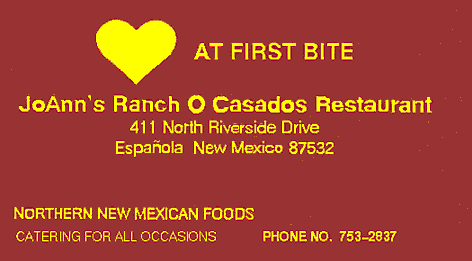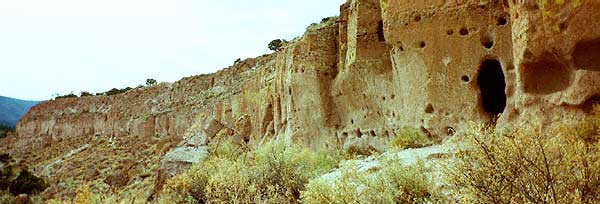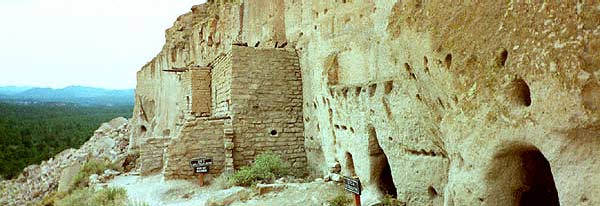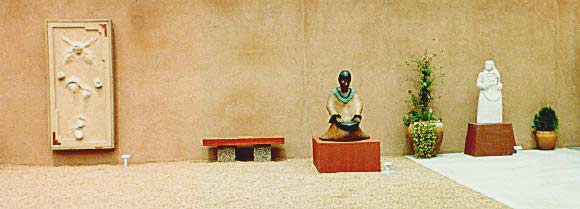
This morning I awoke early. I repacked all of my clean clothes and reorganized my belongings. When I checked out of the motel, I enquired about a place where local people ate breakfast. After they were assured that I did not want a standard fast food breakfast, they directed me to JoAnn's Ranch O Casados Restaurant, a local restaurant a few blocks away. When I entered, it was clear that this place catered to a local clientele. Spanish was the language of the majority present and the sociology was not that of the average Denny's. Everyone there, except me, knew everyone else. Most just ordered "the usual" and were immediately understood. I surveyed neighboring tables and saw that the breakfast burrito was very popular. When I ordered one, smothered in green chile, I was asked whether I wished a full or a half order. As I was hungry, I asked for a full order.

While I waited for my breakfast, I continued my reading of Luci Tapahonso's poetry. This morning's favorite was It Has Always Been This Way. When my breakfast came, I knew I had made a mistake. As in Kayenta with the Navajo tacos, a full order is for the laboring man! While I ate, I quietly watched the interactions among my neighbors. Conversations between the customers and the waitresses were casual, based on daily acquaintence. A pair of men entered the restaurant, a young man in his early twenties and a much older man, perhaps his grandfather from the respect and care with which the young man treated him. It became clear that, while the young man took great care with the ordering of breakfast for the older man, who also needed much help to get comfortable in his chair, the young man wished advice. The conversation was very formal and the young man appeared to be a supplicant. It is hard to imagine seeing this situation played out in the Anglo society.
After breakfast I drove south but shortly turned in toward the Santa Clara Pueblo. I drove past the village toward the ancestral home of the Santa Clara people (Towa), the Puye Cliff Dwellings. As I was the first visitor of the day, the attendant was almost unable to make change for me. By digging into his own pocket, the transaction was completed. I parked near the picnic grounds, got my hiking stick and began the walk up to the deserted dwellings.

These cliff dwellings lie at an altitude of 7000 feet. Except in a few places, all that remain are the rooms that were carved into the sides of the mesa, composed of volcanic tuff, and the holes in the mesa where the roof beams were inserted. This material is soft enough that it can be worked by even wooden tools with enough persistence. Using this method, small rooms were carved into the sides of the cliff, many of them, extending for over a mile along the face of the mesa, and connected by paths. Many rooms had smokeholes cut through the roofs, and old carbon deposits from the fires burned there can still be seen on the ceilings of some rooms. These rooms have been cut into the cliff face on several levels. Ladders, made from local materials, the surrounding pine forest, have been placed in a few locations so that you may climb between levels. Being alone, I did not attempt this.

In a few places the multistory buildings that were built along the front of the mesa wall remain. These buildings were built from "bricks" that were cut from the tuff and then assembled into the buildings. Only a few of these buildings remain, most likely because large chunks of the mesa wall regularly break off and fall, destroying these external buildings. However you can still see, if you look carefully, petroglyphs that were carved into the mesa walls by artists standing on the upper floors, or even the roofs, of these structures.
While returning to the trail down the steep slope, I suddenly became aware of petroglyphs carved into the faces of large blocks of tuff that had fallen from above. It was startling to walk up to these huge carvings along the side of the path. I was not sure whether the images had been carved into the stone while the blocks were in their present location or before they fell. It is very difficult to see these petroglyphs unless the light is right since the rock surface is not smooth and there is no differential weathering of the surface.
I returned to the car and took the road to the top of the mesa. There I found the remains of buildings which had served a large community. At least 2 kivas have been found here. Some walls are still standing 2 floors high. From the top of the mesa you can see the countryside to the south and east for hundreds of miles. While I was wandering along the paths, watching the bird communities feeding in the grasses and shrubs, four people climbed up the ladder from below. In order to escape this break in the silence that I had enjoyed, I found a trail down to the level just below the top and walked slowly past the rooms on this level. I tried to imagine the lives of the people who lived here. Winter here can be cold and snowy, but the rooms (at least those I could walk by) all had a southern exposure. The tuff walls were mostly air and should be good insulators. The buildings on top were built from chunks of the tuff cut for the purpose. Which rooms were used for living area and which were ceremonial? How large a community was supported here? When did they leave? And why?
When it became clear that the traffic was increasing here and I would find no more silence, I went back up to my car and drove down from the top. On my way out, I drove through the current Santa Clara Pueblo. This pueblo consists of one story adobe houses, connected in small groups, distributed around a central plaza and a kiva. Many of the homes have signs indicating that pottery is for sale there. Beyond this village is a set of new homes built on streets set out on a rectangular grid. Here you will also see an occasional deck added on and a few sheet metal garden sheds.
I returned to the highway and turned toward Santa Fe. Almost immediately a road split off to the west leading to Los Alamos, where the atomic bomb was developed during World War II. In the other direction the road goes on past San Ildefonso Pueblo to Pojoaque and past the road to the Nambé Pueblo on which Nambé Lake and Nambé Falls are found. I continue on through the Tesuque Pueblo and into Santa Fe and park at the parking garage just off the plaza which always has space and walk to the museum of the Institute for American Indian Art. I must see the Roxanne Swentzell sculpture of the female koshare again! After I enter the museum, I walk straight to the sculpture garden, but the small aspen grove where the koshare stood is empty! I look all around the grove for some sign of where I may find the koshare and finally assume that they must have moved it inside for the current show. I walk through the rest of the sculpture garden, admiring again the bronze pair of figures by Nora Naranjo-Morse. There is also a new piece, by D. Andrew Rodriguez. I have seen nothing like it before. It is a lifesize portrayal of a dancer literaly emerging from the clay of the wall. I stand across from this piece for a while, looking at the definition given by the shadows, expecting to see him come through the wall at any moment, but he remains frozen in time, always on the verge of entering my world. I then return inside to see the exhibit of work by the students at the IAIA. Many of these pieces are wonderful as well, but I am constantly distracted because I have not seen the Swentzell koshare that has been on my mind for days.

On leaving the exhibit, I stop in the bookstore to get a few presents for my grandchildren. When I pay for the items, I inquire about the koshare sculpture. The student on duty at the cash register has not been there long enough to know this work, but he asks a student who has been there longer. This student remembers the piece. He said that it was badly damaged when blown over by the wind{1}. I am stunned; I feel like someone has punched me in the stomach; this cannot have happened.
I pay for my items and slowly leave the building. I have no heart to look at the work in the museum store. I cursorily look at work in a few galleries, but I cannot stop thinking about the koshare. It cannot be gone. She is still emblazoned in my mind. I can still see her eyes. I finally decide to retrieve my car and drive to Albuquerque. Perhaps on this drive, which I have always loved, I can come to terms with this awful news.
When Luci Tapahonso commuted between Albuquerque and Santa Fe, she wrote her poem A Prayer about that drive. I carry that poem with me whenever I travel, but it is always ready at hand when I drive in the Southwest. There are no other words which can better express my feelings about this landscape and being alone within it. Perhaps I can find some good poems and songs along this road.
While the drive down to Albuquerque
was as beautiful as ever, I remained very upset about the destruction
of the koshare woman (and I still am). I felt very tired so I checked
into a motel near Old Town and walked over to the plaza to get some
dinner. After dinner I walked back to the motel and climbed into bed.
For bedtime reading, I simply reread A
Prayer.
1 I recently had the opportunity to meet and talk with Roxanne Swentzell at her home. I finally worked up the courage to ask her about the koshare woman. Fortunately my worst fears were not confirmed. The sculpture did begin to develop a crack while in the outdoor environment, and she decided to remove it from the IAIA Alan Houser Sculpture Garden in order to prevent further damage. The sculpture has been sold, but, because of the difficulty of shipping such a piece (it is hollow coiled clay, as are Santa Clara pots), it remains at her mother's house in Santa Fe until a safe method of shipping can be assured.
Subscribe to American Indian Art Magazine
Arizona Highways
New Mexico Magazine
Recommend this website to a friend!
Visit The Sonoran Desert 5000 square miles of silence.
References
Books by Luci Tapahonso
Books by Other Authors Whose Work is Seen Here
Books on Pueblo Pottery
Books About Santa Fe
![]() Return to
the Table of Contents
Return to
the Table of Contents